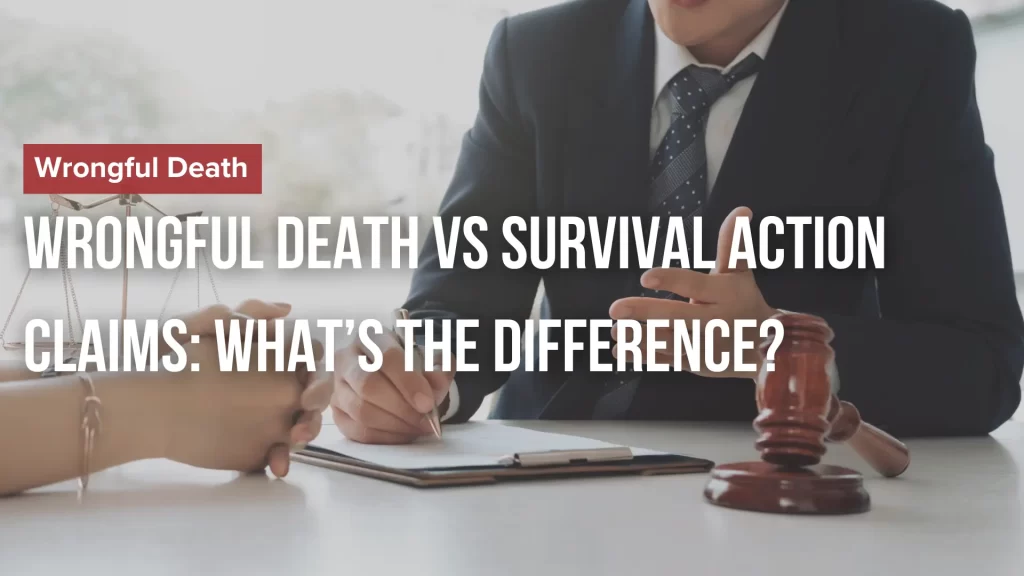
Losing a loved one is devastating. When that loss stems from someone else’s negligence, the pain is compounded by a sense of injustice and a maze of legal questions. In Washington state, families grappling with such tragedies have two powerful legal tools at their disposal: wrongful death claims and survival actions. But what’s the difference between wrongful death vs survival action claims, and which is best suited for your situation?
This distinction isn’t just legal jargon—it can significantly impact your family’s path to justice and financial recovery. At Tamaki Law, we’ve guided countless families through these turbulent waters. Understanding your options is the first step toward healing and accountability.
Understanding Wrongful Death Claims
Surviving family members bring wrongful death claims as legal actions against a party whose negligent or intentional acts have caused the death of a person. These claims seek compensation for the losses suffered by the surviving family members as a result of their loved one’s death.
Key aspects of wrongful death claims include:
- Who can file: In Washington, the personal representative of the deceased person’s estate typically files the claim on behalf of specific surviving family members.
- Eligible beneficiaries: Spouses, domestic partners, children, and sometimes parents or siblings of the deceased may be eligible to receive compensation.
- Types of damages: Compensation may cover economic damages, such as medical expenses associated with the decedent’s final illness or injury, funeral and burial costs, and loss of financial support, as well as non-economic damages, such as loss of companionship and emotional suffering experienced by the surviving family members.
- Statute of limitations: In Washington, wrongful death claims must generally be filed within three years of the date of death.
Exploring Survival Actions
While wrongful death claims focus on the losses suffered by surviving family members, survival actions are different. These claims are brought on behalf of the deceased person’s estate and seek compensation for the damages the deceased person incurred between the time of their injury and their death.
Key features of survival actions include:
- Who can file: The personal representative of the deceased person’s estate files the claim.
- Damages sought: These may include non-economic losses the decedent endured from the time of the accident until the date of their death, including pain and suffering, anxiety, emotional distress, and humiliation.
- Beneficiaries: Any compensation awarded in a survival action becomes part of the deceased person’s estate and is distributed according to their will or state intestacy laws.
- Statute of limitations: The time limit for filing a survival action is typically three years—the same as it would have been if the deceased had survived and filed a personal injury claim.
When Can Both Claims Be Filed?
In many cases, one can file both a wrongful death claim and a survival action simultaneously. This often happens when there’s a period between the initial injury and the person’s death. For instance, a careless driver hits a pedestrian who then spends two weeks in the hospital before succumbing to their injuries. In this case:
- A survival action could seek compensation for the decedent’s pain and suffering experienced during those two weeks.
- A wrongful death claim could pursue damages for the decedent’s medical bills, funeral and burial expenses, and the family’s lost financial support that their loved one would have contributed to the family, as well as the family’s loss of companionship and emotional suffering.
Filing both types of claims ensures that all aspects of the loss are addressed, maximizing the potential for fair compensation.
Challenges in Filing These Claims
While survival actions and wrongful death claims can provide vital compensation, they come with challenges:
- Complex legal procedures: Understanding and managing the requirements for both types of claims can be daunting.
- Emotional stress: Pursuing legal action while grieving can be emotionally taxing for families.
- Proving damages: Especially in survival actions, documenting the deceased’s experiences and losses can be challenging.
- Dealing with insurance companies: Insurers may attempt to minimize payouts, requiring skilled negotiation.
- Time constraints: With statutes of limitations in place, families must act relatively quickly while still dealing with their loss.
Given these challenges, many families find it beneficial to work with experienced attorneys who can guide them through the process and advocate on their behalf.
The Role of a Personal Injury Lawyer in Cases of Wrongful Death
 Dealing with wrongful death and survival action claims can be overwhelming for grieving families, but an experienced attorney can be an invaluable ally. Here are key ways a lawyer can assist families through this challenging process:
Dealing with wrongful death and survival action claims can be overwhelming for grieving families, but an experienced attorney can be an invaluable ally. Here are key ways a lawyer can assist families through this challenging process:
- Provide legal support and strategic guidance
- Gather and analyze crucial evidence
- Accurately calculate damages
- Negotiate with insurance companies
- Represent families in court if necessary
- Manage deadlines and paperwork
- Offer emotional support by handling legal complexities
- Maximize potential compensation
By providing these services, a skilled attorney can significantly improve the chances of a successful outcome in wrongful death and survival action claims while also offering crucial support during a challenging time for the family.
Contact Our Compassionate Wrongful Death Lawyers Today
Understanding the difference between wrongful death and survival action claims is crucial for grieving families. Wrongful death claims cover the family’s future losses. Survival actions address the deceased’s pain and suffering from the injury until death. Pursuing both types of claims often provides the most comprehensive approach to seeking fair compensation.
If you’re facing the tragic loss of a loved one due to someone else’s negligence in Washington state, the Washington wrongful death lawyers at Tamaki Law can explain your legal options and fight for the justice and compensation you deserve.
Call us today at (800) 801-9564 or contact us online for a free, confidential, no-obligation consultation with our experienced lawyers. Our team has been fighting on behalf of injured individuals in Washington since 1994. Let us help you honor your loved one’s memory by ensuring their rights—and yours—are fully protected.
Related Posts:
Immediate Actions After a No-Fault Car Accident in Washington
